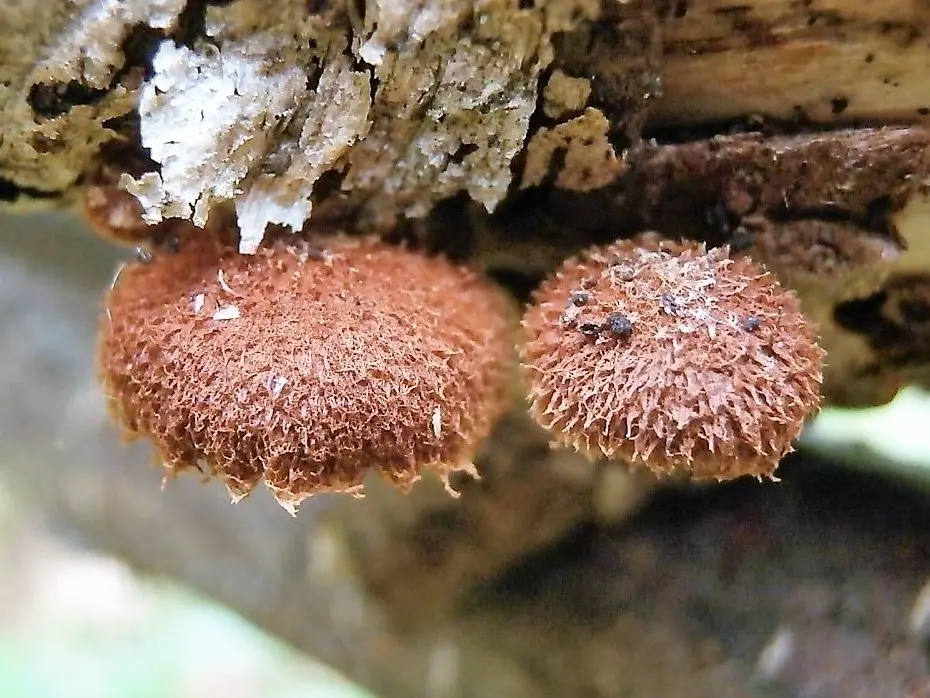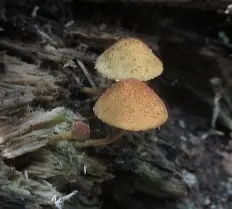Contents
Phaeomarasmius erinaceus (Phaeomarasmius erinaceus)
- Division: Basidiomycota (Basidiomycetes)
- Subdivision: Agaricomycotina (Agaricomycetes)
- Class: Agaricomycetes (Agaricomycetes)
- Subclass: Agaricomycetidae (Agaricomycetes)
- Order: Agaricales (Agaric or Lamellar)
- Family: Tubariaceae (Tubariaceae)
- Genus: Phaeomarasmius (Feomarasmius)
- Type: Phaeomarasmius erinaceus (Feomarasmius erinaceus)
:
- Agaricus erinaceus Fr.
- Pholiota erinaceus (Fr.) Rea
- Naucoria erinacea (Fr.) Gillet
- Dryophila erinacea (Fr.) What.
- Dry agaric Pers.
- Phaeomarasmius dry (Pers.) Singer
- Arid naucoria (Pers.) M. Lange
- Agaricus lanatus sowerby

Current name: Phaeomarasmius erinaceus (Fr.) Scherff. ex Romagn.
Previously, Phaeomarasmius erinaceus was assigned to the Inocybaceae (Fiber) family.
Due to reports of widely varying spore sizes, it is possible that Phaeomarasmius erinaceus is a species complex.
head: up to 1 cm in diameter and only occasionally up to 1,5 cm. At a young age, hemispherical, with a curved edge. With age, opening, it becomes convex or convex-prostrate. Color – from yellowish brown to deep brown. Darker in the center and lighter towards the edges.
The surface of the cap is densely covered with frequent, felted, raised scales. The edge is framed by a fringe of scales that stick together into triangular rays. Thanks to this, Feomarasmius erinaceus looks like a small star nestled on dry trunks.
Records: sparse, relatively thick, rounded, adherent, with intermediate plates. Young mushrooms have a milky cream color. Later – beige. As the spores mature, they acquire a rich, rusty brown color. A light fringe is barely visible along the edge of the plates.

Leg: short, from 3 mm to 1 cm. Cylindrical, often curved. The lower part of the leg is covered with small felt scales. The same color with a hat, red-brown or dark brown. In the upper part of the stem there is an annular zone, above which the surface is smooth or with a slight powdery coating, longitudinally striated. From light beige to yellowish brown.

Microscopy:
The basidia are cylindrical or very slightly widened at the end, up to 6 µm in diameter, ending in two thick, bispore-like, horn-shaped sterigmata.
Spores are smooth, broadly ellipsoid, shaped like a lemon or almond. Germinal pores are absent. Color – light brown. Size: 9-13 x 6-10 microns.
spore powder: Rusty brown.
Pulp Feomarazmius ericilliform is rubbery, rather hard. Color – from light ocher to brown. Without any pronounced smell and taste.
Phaeomarasmius erinaceus is a saprotrophic fungus that grows on dead hardwood. Grows singly and in loose groups. You can see it on fallen and standing trunks, as well as on branches. Prefers willow, but does not disdain oak, beech, poplar, birch, etc.
The mushroom is extremely moisture-loving, the sun is its enemy. Therefore, you can meet him, most of all, on swampy lowlands in the dense shade of trees, or after heavy rains.
Regarding the time, growth of Theomarasmius, different opinions are given in different sources. Some write that the time of its growth is spring. Others – after the autumn rains until the middle of winter.
The situation is clarified by the mention that in Great Britain there are records of the finds of Theomarasmius urchin for each month of the year, except for December. Most likely, it is not too tied to the season, and it is of key importance when it becomes quite humid in its area.
The fungus is distributed in almost all parts of Europe. Also found in the forest zones of North America: in the United States and Canada. You can see it in Western Siberia, as well as marked on the Canary Islands, in Japan and Israel.
There is no information on toxicological data in this fungus, but the very small size and hard rubbery flesh do not allow us to classify Feomarasmius erinaceus as an edible mushroom. Let’s assume it’s inedible.

Flammulaster šipovatyj (Flammulaster muricatus)
Flammulaster šipovatyj (Flammulaster muricatus)
According to the description of macro-features, Flammulaster prickly is close to the description of Feomarasmius urchin. Both are small mushrooms that grow on dead hardwood. Hat with brown shades covered with scales. The stalk also has scales and an annular zone at the top, above which it is smooth. However, upon closer inspection, the differences can be seen.
Prickly Flammulaster is a larger mushroom with fragile flesh, covered with sharp or coarse scales (they are felted in Feomarasmius). In addition, it is not often found on willows. It also gives out a weak rare smell (Feomarasmius urchin practically does not smell of anything).
Photo: Andrey.









